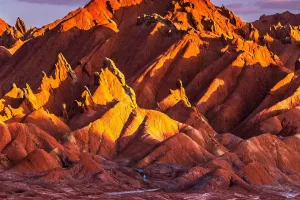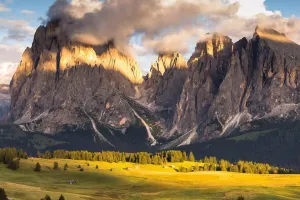Terraced fields, as an important land use method in the agricultural production process of human beings, are not uncommon all over the world. The crops grown on terraced fields around the world are also different due to factors such as the environment. The terraced fields in Europe are mainly planted with grapes and olive trees, while the terraced fields in Asia are mainly cultivated with rice.
On the peaks of the Cordillera Mountains at an altitude of 700 to 1500 meters in the central Luzon Island in the north-central Philippines, there are the largest rice terraces in the world, the Cordillera Rice Terraces. Due to the high altitude, the terraced fields stretch straight up along the mountain, and against the backdrop of the lingering clouds and mists, it looks like a green staircase leading to the kingdom of heaven.
There are more than 20,000 hectares of terraced fields in total, spanning 4 cities and consisting of 5 terraced fields in 4 cities. The combined length can go around half the world, which is a huge project. Therefore, some people call it "the eighth wonder of the world". This terraced field integrates human wisdom 2,000 years ago. In addition to being a cultural phenomenon, it is also a belief. It is the belief of the ancient Ifugao tribe people in the harmonious coexistence of nature and human beings.
About 2,000 years ago, the indigenous tribes living in Ifugao had to cultivate rice terraces in the bare mountains in order to survive. To ensure the fertility of the soil and the retention of water, they used 2-4 meters of rocks to form embankments outside the terraces. The terraced fields here have been irrigated with spring water since ancient times, and the spring water is drawn out by bamboo tubes, and then passes through the sluice gate and flows to the terraced fields, from high to low, there is no shortage of water. And because of the steep mountains, the outer walls of the terraced fields are mostly made of stones, and the terraced fields with neat and well-proportioned steps are amazing.
In the old days when there was no means of transport, these large rocks were all carried by hand. They carried them on their shoulders and by their hands. They worked hard time and time again to wear out their flesh and sweat on this barren land. On the towering mountains, 19,000-kilometer-long embankments were built for the terraced fields. The stone used exceeds that of the Egyptian pyramids and is called "the ladder to heaven".
Since then, there has been a thriving green life on the barren and rugged ridge, which has become a unique terraced rice field in the Philippines. In 1995, it was inscribed on the World Heritage List by UNESCO as a "cultural landscape of organic evolution".
The people of the Ifugao tribe have been isolated from the world over time due to the rugged terrain. No matter how the times develop, they have always adhered to their farming model. Whether it is oral teaching or practical operation, they pass on the farming knowledge. It is for this reason that even though the Philippines was occupied by Spain, it was unexpectedly unaffected and retained its original appearance. So the Cordillera rice terraces, like a living fossil, tell the harmonious story of the fusion of Filipino ancestors with nature 2,000 years ago.
The viewing experience of the terraced fields here is not as good as that of the terraced fields in other places in the world. In addition, the altitude here is high, and the sun has risen to the middle of the sky when the sun can reach the terraced fields. It is estimated that it is even more difficult to take a large film.
Therefore, the foreign tourists who come here are mainly European and American backpackers. They like to follow the local customs, sitting on the roof of the jeepney to watch the terraced fields, and sitting on the ridges in twos and threes to watch the sunset, leisurely. At sunset, either alone or with a lover, wander aimlessly in the ancient tribal village. Seeing some exquisite handicrafts, stopping to play, bargaining with the vendors, and buying one of your own Ifugao wood carvings is a small gain.
The sacred traditional culture and the unique perspective of the landscape make it a beautiful landscape that reflects the integration between human beings and the environment. It is a living cultural landscape with unparalleled beauty and cultural heritage.


